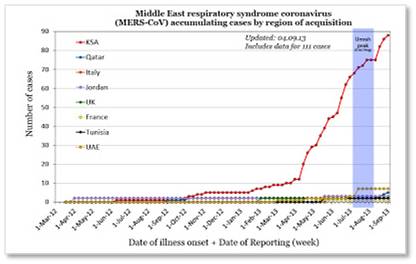At the beginning of July I reported on the appearance of the Middle East Respiratory Syndrome Coronavirus in Saudi Arabia and the possibility of its spread worldwide through two events that draw millions of people to the country this year. The month of September lies in between July’s Ramadan Umrah and the Hajj in October. This seemed like a good time to check in on the progress of efforts to identify the source of the MERS Coronavirus as well as its spread. To see the spread of the disease from its inception, see the chart.
In short, there is good news and there is bad news.
Good News:
- MERS CoV is spreading steadily but not quickly. There have been only 134 cases in 17 months vs. 8000 cases in seven months for the SARS virus.
- Ziad Memish, Saudi Arabia’s deputy health minister, reports that the Ramadan Umrah period passed without a single case appearing among the 4,800,000 participants. This sounds good but what this really means, however, is that that a disease severe enough to be put on the radar for MERS testing, was not diagnosed in those people. Recombinomics reports a case in August in a Qatari national and some carriers have been asymptomatic.
- The virus is most lethal among the old, the very young, pregnant women and sick people with compromised immune systems, a population that can be identified and isolated.
- Clusters of the infected are small, fewer than a dozen people, and the disease appears to run its course after that.
Bad News:
- MERS CoV is spreading steadily but quietly. Unlike a SARS-type outbreak, it is not making headlines or generating alarm among the general population. In this case, ignorance makes for a dangerous complacency.
- The source of the virus has still not been identified so experts don’t know how people are being exposed. Both camels and bats have been tested but the results of those studies were inconclusive.
- The disease has a 42% mortality rate, down from 52% in June, but that’s vs. 9% for SARS and 2.5% for the influenza pandemic of 1918-1919.
- Eleven people have died in the remote Saudi town of Hafr al Batin, including a 39-year-old man.
- Most news outlets have ignored the outbreak. Only The Wall Street Journal is following it with any regularity. Today’s article, “Saudi Efforts to Stop MERS Virus Faulted,” is the latest. Ignorance is not bliss.
- The number of new cases has jumped in recent weeks.
Hajj Recommendations:
The Because of the risk of MERS, the Saudi Arabian Ministry of Health has recommended that the following groups should postpone their plans for Hajj and Umrah this year:
- People over 65 years old
- Children under 12 years old
- Pregnant women
- People with chronic diseases (such as heart disease, kidney disease, diabetes, or respiratory disease)
- People with weakened immune systems
- People with cancer or terminal illnesses
The World Health Organization, which is coordinating the global response to this outbreak, has issued its own set of recommendations for travelers to Saudi Arabia including measures to take before, during, and after the Hajj. They encourage countries to raise awareness of their travel advice. The Centers for Disease Control and Prevention has also issued advice to protect the more than 11,000 Americans who are expected to perform the Hajj. These guidelines deal with MERS CoV as well as other infection diseases including Polio, meningococcal meningitis, hepatitis A and B, and typhoid.
The Bottom Line
The bottom line seems to be that we still don’t know anywhere near enough about this lethal virus and the World Health Organization is holding an emergency meeting next Wednesday to discuss the disease. Individuals are urged to report any MERS-like symptoms and medical facilities are directed to be on the alert but WHO does not recommend applying any travel or trade restrictions or entry screening for returning pilgrims.
This seems like a pretty tepid effort to me. MERS symptoms can be misinterpreted as having other causes, dismissed by people in denial, or simply disregarded. Families might also hide an infected member out of fear of being stigmatized. And these guidelines are useless for the asymptomatic carriers. Didn’t anybody at WHO see World War Z? Or Contagion?
So we’re left with the combination of a lethal disease with no known source or method of transmission, that most people have never heard of, that may be carried without symptoms and an event that is expected to draw nearly four million pilgrims to the point of origin. I would think more than voluntary reporting and “be on the lookout” directives are indicated. But I’m not a healthcare professional.


